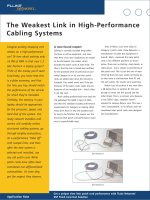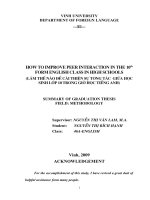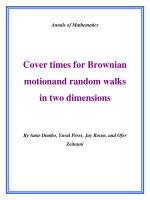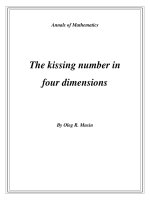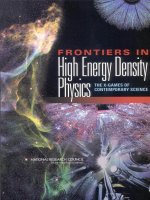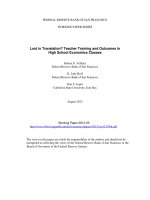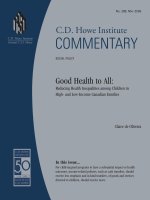orbital angular momentum entanglement in high dimensions
Bạn đang xem bản rút gọn của tài liệu. Xem và tải ngay bản đầy đủ của tài liệu tại đây (14.95 MB, 191 trang )
Glasgow Theses Service
Giovannini, Daniel (2014) Orbital angular momentum entanglement in
high dimensions. PhD thesis.
Copyright and moral rights for this thesis are retained by the author
A copy can be downloaded for personal non-commercial research or
study, without prior permission or charge
This thesis cannot be reproduced or quoted extensively from without first
obtaining permission in writing from the Author
The content must not be changed in any way or sold commercially in any
format or medium without the formal permission of the Author
When referring to this work, full bibliographic details including the
author, title, awarding institution and date of the thesis must be given
Orbital angular momentum
entanglement in
high dimensions
Daniel Giovannini
SUBMITTED IN FULFILMENT OF
THE REQUIREMENTS FOR THE DEGREE OF
DOCTOR OF PHILOSOPHY
School of Physics and Astronomy
College of Science and Engineering
University of Glasgow
November 2014
Abstract
Orbital angular momentum (OAM) is one of the most recently discovered prop-
erties of light, and it is only in the past decade its quantum properties have been
the subject of experimental investigations and have found applications. Unlike
polarization, which is only bidimensional, orbital angular momentum provides,
with relative ease, unprecedented access to a theoretically unbounded discrete
state space.
The process of spontaneous parametric down-conversion has long been used
as a source of two-photon states that can be entangled in several degrees of free-
dom, including OAM. In this thesis, the properties of the natural OAM spectrum
associated with the entangled states produced by parametric down-conversion
were investigated. Chapters 2 and 3 describe the production and detection of
tunable high-dimensional OAM entanglement in a down-conversion system.
By tuning the phase-matching conditions and improving the detection stage,
a substantial increase in the half-width of the OAM correlation spectrum was
observed.
The conjugate variable of OAM, angular position, was also considered when
examining high-dimensional states entangled in OAM. In order to efficiently
determine their dimension, high-dimensional entangled states were probed
by implementing a technique based on phase masks composed of multiple
angular sectors, as opposed to narrow single-sector analysers. Presented in
chapter 4, this technique allows the measurements of tight angular correlations
while maintaining high optical throughput.
The states so produced were then used for a number of applications centred
around the concept of mutually unbiased bases. One can define sets of mutually
III
unbiased bases for arbitrary subspaces of the OAM state space. Two bases are
mutually unbiased if the measurement of a state in one basis provides no infor-
mation about the state as described in the other basis. Complete measurements
in mutually unbiased bases of high-dimensional OAM spaces are presented
in chapter 5. Measurements in sets of mutually unbiased bases are integral to
quantum science and can be used in a variety of protocols that fully exploit the
large size of the OAM state space; we describe their use in efficient quantum
state tomography, quantum key distribution and entanglement detection.
Caution is however necessary when dealing with state spaces embedded in
higher-dimensional spaces, such as that provided by OAM. Experimental tests
of Bell-type inequalities allow us to rule out local hidden variable theories in the
description of quantum correlations. Correlations inconsistent with the states
observed, or even with quantum mechanics, known as super-quantum correla-
tions, have however been recorded previously in experiments that fail to comply
with the fair-sampling conditions. Chapter 6 describes an experiment that
uses a particular choice of transverse spatial modes for which super-quantum
correlations persist even if the detection is made perfectly efficient.
The sets of modes carrying OAM allow a complete description of the trans-
verse field. The ability to control and combine additional degrees of freedom
provides the possibility for richer varieties of entanglement and can make quan-
tum protocols more powerful and versatile. One such property of light, associ-
ated with transverse modes possessing radial nodes in the field distribution, can
be accessed within the same type of experimental apparatus used for OAM. In
chapter 7, the radial degree of freedom is explored, together with OAM, in the
context of Hong-Ou-Mandel interference.
IV
Contents
List of tables IX
List of figures XII
Acknowledgements XIII
Author’s declaration XV
Publications XVII
1 Introduction 1
1.1 The quantum nature of light . . . . . . . . . . . . . . . . . . . . . . 1
1.2 Quantum entanglement . . . . . . . . . . . . . . . . . . . . . . . . . 3
1.3 The angular momentum of light . . . . . . . . . . . . . . . . . . . . 5
1.3.1 Spin and orbital angular momentum . . . . . . . . . . . . . 6
1.3.2 Measuring spin and orbital angular momentum . . . . . . . 8
1.3.3 The paraxial approximation . . . . . . . . . . . . . . . . . . . 10
1.3.4
Duality relation between orbital angular momentum and
angular position . . . . . . . . . . . . . . . . . . . . . . . . . . 13
1.4 The angular momentum of light as a quantum resource . . . . . . 15
2 Production and measurement of OAM-entangled two-photon states 19
2.1 Spontaneous parametric down-conversion . . . . . . . . . . . . . . 19
2.1.1 Phase-matching . . . . . . . . . . . . . . . . . . . . . . . . . . 20
2.1.2 The Klyshko advanced wave model . . . . . . . . . . . . . . 25
2.2 Entanglement of orbital angular momentum . . . . . . . . . . . . . 28
V
2.3 Experimental methods . . . . . . . . . . . . . . . . . . . . . . . . . . 32
2.3.1 Collinear parametric down-conversion with BBO crystals . 32
2.3.2
Phase-flattening measurements with spatial light modulators
34
2.3.3 Coincidence detection . . . . . . . . . . . . . . . . . . . . . . 37
3 Generation of high-dimensional OAM-entangled states 39
3.1 Spiral bandwidth . . . . . . . . . . . . . . . . . . . . . . . . . . . . . 41
3.1.1 Analytical treatment of spiral bandwidth . . . . . . . . . . . 44
3.1.2 Geometrical argument . . . . . . . . . . . . . . . . . . . . . . 46
3.1.3 Optimization of orbital angular momentum bandwidths . 50
3.1.4 Optical étendue and dimensionality . . . . . . . . . . . . . . 52
3.2 Increasing the spiral bandwidth in parametric down-conversion . 53
3.2.1 Experimental results . . . . . . . . . . . . . . . . . . . . . . . 54
3.2.2
Angular two-photon interference and entanglement mea-
sures . . . . . . . . . . . . . . . . . . . . . . . . . . . . . . . . 57
3.3 Pump shaping . . . . . . . . . . . . . . . . . . . . . . . . . . . . . . . 59
3.3.1 SPDC with a phase-flipped Gaussian mode as pump . . . . 61
3.3.2 Experiment and results . . . . . . . . . . . . . . . . . . . . . 63
4 Efficient determination of the dimensionality of bipartite OAM entan-
glement 67
4.1 Angular slits and phase masks . . . . . . . . . . . . . . . . . . . . . 69
4.2 Shannon dimensionality . . . . . . . . . . . . . . . . . . . . . . . . . 70
4.3
Experimental determination of the effective dimensionality of bi-
partite OAM entanglement . . . . . . . . . . . . . . . . . . . . . . . 72
4.3.1 Experimental set-up . . . . . . . . . . . . . . . . . . . . . . . 72
4.3.2 Experimental results and discussion . . . . . . . . . . . . . . 75
5 Mutually unbiased bases in high-dimensional subspaces of OAM: mea-
surement and applications 79
5.1
Measuring high-dimensional orbital angular momentum states in
MUB . . . . . . . . . . . . . . . . . . . . . . . . . . . . . . . . . . . . 81
5.1.1 Mutually unbiased bases . . . . . . . . . . . . . . . . . . . . 81
5.1.2 Mutually unbiased bases for OAM subspaces . . . . . . . . 84
VI
5.1.3 Experimental methods . . . . . . . . . . . . . . . . . . . . . . 85
5.2
Efficient high-dimensional quantum state reconstruction with
mutually unbiased bases . . . . . . . . . . . . . . . . . . . . . . . . . 89
5.2.1 Mutually unbiased bases in quantum state tomography . . 89
5.2.2 State reconstruction methods . . . . . . . . . . . . . . . . . . 92
5.2.3 Results . . . . . . . . . . . . . . . . . . . . . . . . . . . . . . . 94
5.3
Quantum key distribution with high-dimensional OAM mutually
unbiased bases . . . . . . . . . . . . . . . . . . . . . . . . . . . . . . 98
5.3.1 Average error rate . . . . . . . . . . . . . . . . . . . . . . . . . 100
5.3.2 Secret key rate . . . . . . . . . . . . . . . . . . . . . . . . . . . 102
5.3.3 Experiment and result . . . . . . . . . . . . . . . . . . . . . . 104
5.4 Entanglement detection with mutually unbiased bases . . . . . . . 106
6 Fair sampling in
high-dimensional state spaces 109
6.1 Fair sampling in Bell-type experiments . . . . . . . . . . . . . . . . 111
6.2 Synthesizing super-quantum correlations with spatial modes . . . 113
6.3 Sampling high-dimensional state spaces . . . . . . . . . . . . . . . 117
7 Extending the Hilbert space of transverse modes using the radial de-
gree of freedom 123
7.1 The radial degree of freedom . . . . . . . . . . . . . . . . . . . . . . 124
7.2
Interference of probability amplitudes in the Hong-Ou-Mandel
effect . . . . . . . . . . . . . . . . . . . . . . . . . . . . . . . . . . . . 126
7.3 Exploring the quantum nature of the radial degree of freedom . . 133
8 Conclusions 141
A Mutually unbiased vectors 145
A.1 Coefficients for d =2 . . . . . . . . . . . . . . . . . . . . . . . . . . . 145
A.2 Coefficients for d =3 . . . . . . . . . . . . . . . . . . . . . . . . . . . 145
A.3 Coefficients for d =4 . . . . . . . . . . . . . . . . . . . . . . . . . . . 146
A.4 Coefficients for d =5 . . . . . . . . . . . . . . . . . . . . . . . . . . . 147
B List of abbreviations 149
VII
Bibliography 170
VIII
List of Tables
3.1 Phase-flipped Gaussian mode decomposition . . . . . . . . . . . . 62
5.1
Results of tomographic reconstructions with mutually unbiased
measurements . . . . . . . . . . . . . . . . . . . . . . . . . . . . . . . 97
7.1
Expansion coefficients for the transverse modes used in radial
Hong-Ou-Mandel interference . . . . . . . . . . . . . . . . . . . . . 137
IX
X
List of Figures
1.1 Spin and orbital angular momentum of light . . . . . . . . . . . . . 5
1.2
Propagation of the Poynting vector associated with a Laguerre-
Gaussian mode . . . . . . . . . . . . . . . . . . . . . . . . . . . . . . 8
1.3 Transfer of spin and orbital angular momentum . . . . . . . . . . . 9
2.1 Parametric down-conversion configuration . . . . . . . . . . . . . 21
2.2 Pump, signal and idler wave vectors in SPDC . . . . . . . . . . . . . 22
2.3
Collinear and noncollinear phase matching SPDC intensity distri-
butions. . . . . . . . . . . . . . . . . . . . . . . . . . . . . . . . . . . . 26
2.4 Klyshko model of down-conversion . . . . . . . . . . . . . . . . . . 27
2.5 Experimental parametric down-conversion set-up . . . . . . . . . 33
2.6 Computer generated-holograms . . . . . . . . . . . . . . . . . . . . 35
3.1
Schmidt number and full width at half maximum of an OAM spec-
trum, and Schmidt number as a function of crystal length and
pump beam size . . . . . . . . . . . . . . . . . . . . . . . . . . . . . . 47
3.2 Spiral bandwidth and angular position correlations . . . . . . . . . 54
3.3
Concurrence measurements for different phase-matching condi-
tions . . . . . . . . . . . . . . . . . . . . . . . . . . . . . . . . . . . . . 58
3.4
OAM and angular position correlations for a phase-flipped Gaus-
sian pump . . . . . . . . . . . . . . . . . . . . . . . . . . . . . . . . . 64
4.1
Typical best Gaussian fits of coincidence probability distributions
for multi-sector phase masks . . . . . . . . . . . . . . . . . . . . . . 73
4.2 Detected spiral bandwidhts with forked holograms . . . . . . . . . 74
XI
4.3
Detection capabilities of multi-sector phase masks and experimen-
tal results . . . . . . . . . . . . . . . . . . . . . . . . . . . . . . . . . . 75
5.1 State spaces of a bipartite system . . . . . . . . . . . . . . . . . . . . 83
5.2 Mutually unbiased modes for a two-dimensional OAM subspace . 84
5.3 Mutually unbiased modes for a three-dimensional OAM subspace 87
5.4 Mutually unbiased modes for a five-dimensional OAM subspace . 88
5.5
Overcomplete and complete quantum state tomography with MUB
89
5.6
Single-photon measurements in OAM subspaces of entangled two-
photon states . . . . . . . . . . . . . . . . . . . . . . . . . . . . . . . 93
5.7
Results of tomographic reconstructions using complete sets of
single-photon mutually unbiased bases measurements . . . . . . 95
5.9 Quantum key distribution parameters for full sets of MUB . . . . . 101
5.10 Mutual correlation for entanglement detection with MUB . . . . . 105
6.1 Two- and four-channel Bell-type experiments . . . . . . . . . . . . 110
6.2 Fourier synthesis of a square wave . . . . . . . . . . . . . . . . . . . 114
6.3
Coincidence curves for an OAM Bell-type experiment with orientation-
dependent post-selection and recorded values of Bell parameter
S
as a function of the relative analyser orientation . . . . . . . . . . . 116
6.4
Theoretical coincidence probabilities and Bell parameters for Bell-
type experiments with polarization and OAM sector states, without
renormalization . . . . . . . . . . . . . . . . . . . . . . . . . . . . . . 118
7.2
Hong-Ou-Mandel coincidence dips for different placements of
narrow-band filters . . . . . . . . . . . . . . . . . . . . . . . . . . . . 130
7.3
Hong-Ou-Mandel dips for filters with different bandwidths placed
before and after the beam splitter . . . . . . . . . . . . . . . . . . . 131
7.4
Experimental set-up for the observation of Hong-Ou-Mandel in-
terference in the radial degree of freedom . . . . . . . . . . . . . . . 134
7.5
Experimental data of the Hong-Ou-Mandel interference in the
radial degree of freedom . . . . . . . . . . . . . . . . . . . . . . . . . 136
XII
Acknowledgements
This thesis would not have been possible if not for the passion and enthusiasm
of my supervisor, Miles, who has provided guidance and support throughout
my entire PhD. I would also like to thank Sonja, who has been a valuable second
supervisor.
My gratitude also goes to EPSRC, for providing the funds that supported my
PhD.
I would like to thank Jacqui, for her irreplaceable help on both experimental
and theoretical matters. Also, thank you Filippo, Andrew, Melanie, Angela and
all who I have had the pleasure to work with at different times.
Thanks to all current and past members of the Optics group at the Univer-
sity of Glasgow for being excellent human beings first, for the variety of their
expertise and the willingness with which they share it, and for the copious
amounts of cake, countless pints, many barbecues and the occasional wacky
cycling/unicycling/climbing adventure that we have enjoyed together.
I would like to thank Robert Boyd for welcoming me to his research group
at the University of Ottawa during my 2013 research exchange, which was sup-
ported by the College of Science and Engineering at the University of Glasgow.
Thank you, Valerio and David, for the 24/7 transnational banter and for being
constant reminders of what it is actually like to be good physicists at our age.
My thanks also go to the Quantum Optics group at Sapienza University of
Rome: without your lectures and mentoring I may have never become interested
in experimental physics and quantum optics during my undergraduate studies.
XIII
Author’s declaration
I hereby declare that this thesis is the result of my own work, except where
explicit reference is made to the work of others, and has not been presented in
any previous application for a degree at this or any other institution.
Daniel Giovannini
XV
Publications
This thesis is the culmination of the work carried out during my PhD in the Optics
group at the University of Glasgow, under the supervision of Prof. Miles Padgett
and Dr. Sonja Franke-Arnold. A list of the peer-reviewed papers co-authored in
the three and a half years of the PhD programme is given below.
1.
F. M. Miatto,
D. Giovannini
, J. Romero, S. Franke-Arnold, S. M. Barnett
and M. J. Padgett, “Bounds and optimisation of orbital angular momen-
tum bandwidths within parametric down-conversion systems”, European
Physical Journal D 66(7), 178 (2012)
2. D. Giovannini
, F. M. Miatto, J. Romero, S. M. Barnett, J. P. Woerdman and
M. J. Padgett, “Determining the dimensionality of bipartite orbital-angular-
momentum entanglement using multi-sector phase masks”, New Journal
of Physics 14(7), 073046 (2012)
3.
J. Romero,
D. Giovannini
, S. Franke-Arnold, S. M. Barnett and M. J. Padgett,
“Increasing the dimension in high-dimensional two-photon orbital angular
momentum entanglement”, Physical Review A 86(1), 012334 (2012)
4.
J. Romero,
D. Giovannini
, M. G. McLaren, E. Galvez, A. Forbes and M. J. Pad-
gett, “Orbital angular momentum correlations with a phase-flipped Gaus-
sian mode as pump beam”, Jou rnal of Optics 14(8), 085401 (2012)
5. D. Giovannini
, J. Romero, J. Leach, A. Dudley, A. Forbes and M. J. Padgett,
“Characterization of high-dimensional entangled systems via mutually
unbiased measurements”, Physical Review Letters 110(14), 143601 (2013)
XVII
6.
J. Romero,
D. Giovannini
, S. M. Barnett and M. J. Padgett, “Tailored two-
photon correlation and fair-sampling: a cautionary tale”, New Journal of
Physics 15(8), 083047 (2013)
7.
M. Mafu, A. Dudley, S. Goyal,
D. Giovannini
, M. McLaren, M. J. Padgett,
T. Konrad, F. Petruccione, N. Lütkenhaus and A. Forbes, “Higher-dimensional
orbital angular momentum based quantum key distribution with mutually
unbiased bases”, Physical Review A 88(3), 032305 (2013)
8.
E. Karimi,
D. Giovannini
, E. Bolduc, N. Bent, F. M. Miatto, M. J. Padgett
and R. W. Boyd, “Exploring the quantum nature of the radial degree of
freedom of a photon via Hong-Ou-Mandel interference”, Physical Review
A 89, 013829 (2014)
9. D. Giovannini
, J. Romero and M. Padgett, “Interference of probability am-
plitudes: a simple demonstration within the Hong-Ou-Mandel experi-
ment”, Journal of Optics 16(3), 032002 (2014)
“Quantum information [ ] is fragile and private, more like the
information in a dream. Many people can read a book and get
the same message, but trying to tell people about your dream
changes your memory of it, so that eventually you forget the
dream and remember only what you said about it.”
— Charles H. Bennett, Publicity, Privacy,
and Permanence of Information
“[W]ith each change, the old machines were forgotten and
new ones took their place. Very slowly, over thousands of years,
the ideal of the perfect machine was approached – that ideal
which had once been a dream, then a distant prospect, and at
last reality.”
— Arthur C. Clarke, The City and the Stars
CHAPTER 1
Introduction
1.1 The quantum nature of light
Since its outset, quantum mechanics has been intimately intertwined with
the properties of electromagnetic radiation. Quantum theory originated in
the early 20th century with Max Planck’s attempts to treat and describe black-
body radiation [
210
]. In order to explain the spectral distribution of energy
radiated by a thermal source, Planck postulated that energy is exchanged in
multiples of the fundamental constant
, multiplied by the angular frequency
ω
of the radiation that mediates the exchange. The concept of photon was
thus introduced, although the term itself
1
was coined only later, in 1926, by
Gilbert Lewis [
164
]. The shift from Planck’s original definition of a quantum
of l ight as the smallest discrete wave packet to the definition of the photon as
a particle-like entity, and back, is at the heart of quantum mechanics. While
the concepts of particle and wave are borrowed from classical mechanics, the
theoretical and experimental advances that brought about the paradigm shift
of particle-wave duality highlight the intrinsic complementarity of these two
ideas in the quantum world. Either of the two manifestations of the photon
can be observed, based on the formalism and measurement device employed
[
48
]. This duality is one of the facets of the complementarity principle, one
1
Arthur Compton is also sometimes credited with introducing the term in 1923 [153].
1
2 CHAPTER 1
of the foundational notions of quantum mechanics, at least in the traditional
Copenhagen interpretation.
Farther still from the ideas of classical physics is the introduction of proba-
bility amplitudes in the description of wave packets. The use of probabilities to
describe the relationship between the interpretation of physical phenomena and
the manifestations of their inherent reality rendered quantum mechanics as a
whole a fundamentally statistical theory, and whose physical significance is still
debated [
219
]. However, it also finally allowed the descriptions of effects such as
single-particle interference – effects often demonstrated, since the early days
of quantum mechanics, by passing non-overlapping pulses of attenuated light
first, and later on individual photons, through a double slit or a Mach-Zender
interferometer.
Over the decades, light has therefore been instrumental in the experimental
studies that spurred the development of quantum theory, as well as the further
countless experimental tests of the very same theories. As a resource in quan-
tum science, light possesses several drawbacks: the interactions of photons
with most physical systems is negligible, and the efficient production of single
photons (though probabilistic) remains challenging. Since the inception of the
laser in the 1960s, however, many desirable properties of light have also emerged
or have become more easily accessible. In the theory of electromagnetic radi-
ation in an optical cavity, fields can only be excited in discrete spatial modes;
calculations and results obtained in this simplified framework can readily be
extended to more general unconfined systems that include laser cavities, linear
and nonlinear optical elements [
170
]. Developments in nonlinear and quantum
optics, and the introduction in experimental practice over the past half century
of technological advances, have made many photonic quantum experiment
possible. This, as well as the convenience and high degree of coherence and
monochromaticity of laser sources, have provided full control of the vast range
of quantum properties of light — some of which, like orbital angular momentum,
have started being explored only as recently as twenty years ago [9].
SECTION 1.2 3
1.2 Quantum entanglement
Entanglement is one of the defining features of quantum mechanics with no
classical equivalent. The concept of entanglement, which represents a depar-
ture from pre-existing notions of local relativistic causality and counterfactual
realism in classical mechanics, was made necessary by the impossibility to re-
produce some predictions of quantum mechanics by means of local theories.
In their seminal 1935 paper, Albert Einstein, Boris Podolsky and Nathan Rosen
(EPR) presented a thought experiment whose goal was to point out the apparent
incompleteness of quantum mechanics in the then current formulation [
95
].
EPR described two subsystems which have been made to interact in such a way
that their properties (such as position and momentum) remain correlated even
after the subsystems have been spatially separated. The predictions for an EPR
state cannot be reproduced by classical theories, like hidden-variable models; in
the assumption that quantum mechanics were indeed a locally causal theory,
Einstein, Podolsky and Rosen thus concluded that it must either fulfil local real-
ism or be considered incomplete — in the sense that the state wavefunction is
not a complete quantum-mechanical description of reality.
It was Erwin Schrödinger who, shortly afterwards, introduces the term en-
tanglement, first in a letter to Einstein, then in an influential paper in which he
tackled the apparent paradoxical nature of the EPR experiment and described
the newly christened term “the characteristic trait of quantum mechanics” [
240
].
It wasn’t until 1964 however that John Bell overturned one of the underlying as-
sumptions of the EPR argument, the principle of locality [
34
,
35
]. Bell proposed
an inequality to test for the existence of local hidden variables, which would
allow correlations between two system that would otherwise require Einstein’s
“spooky action at a distance”. The outcomes of appropriate sets of measurements
define an upper bound for systems exhibiting locality. Nonlocal systems, which
include quantum states, violate Bell’s inequality and its alternative formulations,
thus ruling out the possibility of hidden variable theories [
105
]. Beginning only
in the early 1980s due to the challenging nature of experimental tests of local
realism, this has been shown in a vast number of experiments, pioneered by
Aspect, Grangier and Roger [
17
,
18
,
16
] and also aided by the reformulation of
4 CHAPTER 1
Bell’s bound in terms of the CHSH inequality
2
[76, 75].
The main possible experimental loopholes affecting Bell-type tests, which
could mask the presence of hidden variables by introducing a statistical bias,
have by now been closed for different types of quantum systems [
273
,
232
,
114
].
While a completely loophole-free Bell test has still to be performed, the current
insight into the nature of entanglement seems to favour a nonlocal view [
65
]. It
has also been shown how shared randomness (that is, the presence of classical
communication between the parties prior to the measurement or established at
the source), while introducing a form of nonlocal correlations, is not enough for
the correlations to violate Bell-type inequalities [107].
It is important to highlight how nonlocality does not play any role in the
definition of entanglement. Entanglement is indeed a nonlocal phenomenon,
where separated systems share properties in a way that goes beyond classical
mechanics. It can however be defined simply in terms of tensor products of
states belonging to different Hilbert spaces. If the state of a physical system can
be in one of many configurations, then according to the superposition principle
the most general state is in fact expressed by a linear combination of all the
different possibilities. As an example, let us take a pure state
|ψ〉
in the Hilbert
space
H
associated with the composite system described by
H
1
⊗H
2
. By taking
as a basis for the system the tensor products of the
d
-dimensional basis vectors
in the subsystem spaces H
1
and H
2
respectively, we may write
|ψ〉=
d
i,j =1
c
i j
|i〉
1
⊗|j 〉
2
. (1.1)
The overall state
|ψ〉
is said to be entangled if it cannot be expressed as a prod-
uct state of states describing the two subsystems. Conversely, it is said to be
separable if it can be expressed in the form
|ψ〉=|ζ〉
1
⊗|θ〉
2
(1.2)
in an appropriate basis. These ideas can of course be applied in theory to multi-
2
CHSH stands for John Clauser, Michael Horne, Abner Shimony and Richard Holt, who
described the inequality in 1969.
